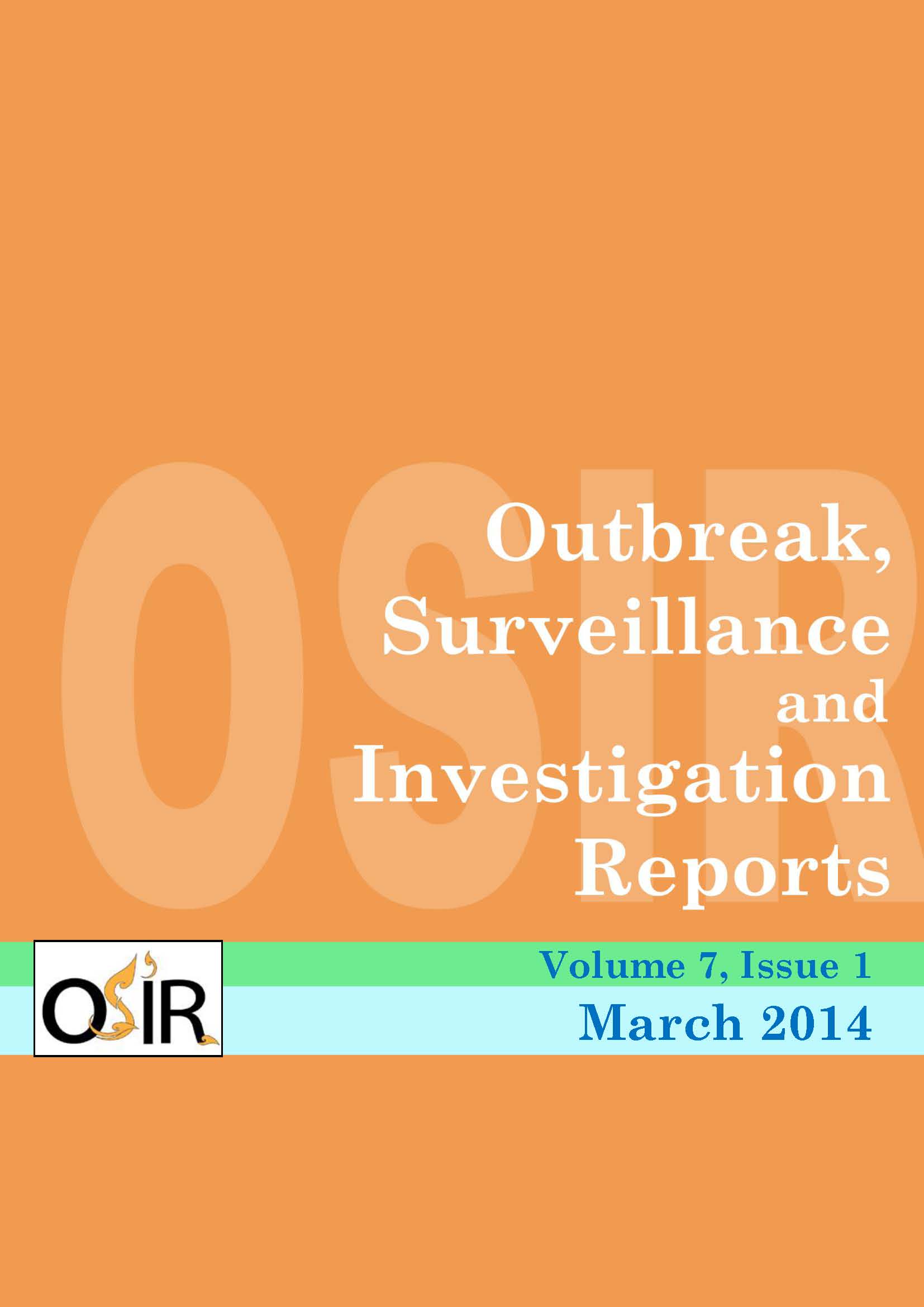Investigation of A Severe Enteroviral Encephalitis and Circulating Genotypes during Hand, Foot and Mouth Disease Surge in Nakhon Ratchasima Province, Thailand, August 2011
DOI:
https://doi.org/10.59096/osir.v7i1.263295Keywords:
encephalitis, HFMD, enterovirus, EV-71, coxsackie B5, Nakhon Ratchasima, ThailandAbstract
On 7 Aug 2011, a 1-month-old baby with encephalitis caused by unspecified enterovirus was reported during the period of widespread hand, foot and mouth disease (HFMD) outbreaks in Nakhon Ratchasima Province. An investigation was carried out to confirm the diagnosis, identify etiology of all severe enteroviral infection cases, determine magnitude of HFMD and enterovirus infection, including asymptomatic infections, and recommend prevention and control measures. A descriptive study was conducted by interviewing family members of the index case. Throat swab and stool specimens were collected to identify enterovirus. Survey on asymptomatic infection was done in schools attended by the index case’s siblings. Stool culture and isolation for enterovirus were also performed. Coxsackie B5 virus was isolated from fresh stool specimens of the index case. Among total 244 students screened for HFMD symptoms in four schools, only seven (3%) met the suspect case definition. During HFMD outbreaks caused by EV-71 B5, coxsackie A16 and coxsackie B5, proportion of asymptomatic infection among students was 22%. Risk factors such as no soap in toilets and misuse of alcohol gel to clean hands in schools were observed during the environmental survey.
References
Centers for Disease Control and Prevention. Hand, foot, and mouth disease (HFMD. 2012 Apr 27. [cited 2013 Feb 8]. <http://www.cdc.gov/hand-foot-mouth/about/index.html>
Rajtar B, Majek M, Polański Ł, Polz-Dacewicz M. Enteroviruses in water environment--a potential threat to public health. Ann Agric Environ Med. 2008 Dec;15(2):199-203.
Ashkenazi A, Melnick JL. Enteroviruses - a review of their properties and associated diseases. Am J Clin Pathol. 1962 Sep;38:209-29.
Dery P, Marks MI, Shapera R. Clinical manifestations of Coxsackievirus infections in children. Am J Dis Child. 1974;128(4): 464-8.
Sainani GS, Dekate MP, Rao CP. Heart disease caused by coxsackie virus B infection. Br Heart J. 1975 August; 37(8): 819-23.
Whitehead JEM. Silent infections and the epidemiology of viral carditis. Am Heart J. 1973 May;85(5):711-3.
Burch GE, Sun SC, Chu KC, Sohal RS, Colcolough HL. Interstitial and coxsackievirus B myocarditis in infants and children. A comparative histologic and immunofluorescent study of 50 autopsied hearts. JAMA. 1968 Jan 1;203(1):1-8.
Gelfand HM, Holguin AH. Enterovirus infections in healthy children. Arch Environ Health. 1962:5(5):404-11.
Chang LY, Huang YC, Lin TY. Fulminant neurogenic pulmonary oedema with hand, foot, and mouth disease. Lancet. 1998 Aug 1;352(9125):367-8.
Mirand A, Henquell C, Archimbaud C, Ughetto S, Antona D, Bailly JL, et al. Outbreak of hand, foot and mouth disease/herpangina associated with coxsackievirus A6 and A10 infections in 2010, France: a large citywide, prospective observational study. Clin Microbiol Infect. 2012 May;18(5):E110-8. Epub 2012 Mar 8.
Mizzima News. HFMD affecting children in Southeast Asia. 2012 Jul 26. [cited 2013 Feb 5] <http://www.mizzima.com/news/regional/7608-cattle-disease-affecting-children-in-southeast-asia.html>
Buathong R, Hanshoaworakul W, Sutdan D, Iamsirithaworn S, Pongsuwanna Y, Puthawathana P, et al. Cluster of fatal cardiopulmonary failure among children caused by an emerging strain of enterovirus 71, Nakhorn Ratchasima Province, Thailand, 2006. OSIR. 2008 Aug;1(1):1-3.
Thailand. Bureau of Epidemiology. Department of Disease Control. Ministry of Public Health. Hand, foot and mouth disease surveillance. [cited 2013 May 1]. <http://www.boe.moph.go.th/boedb/d506_1/ds.php>
Linsuwanon P, Puenpa J, Huang SW, Wang YF, Mauleekoonphairoj J, Wang JR, et al. Epidemiology and seroepidemiology of humanenterovirus 71 among Thai populations, J Biomed Sci. 2014 Feb 18;21:16. doi: 10.1186/1423-0127-21-16.
Ma H, Huang X, Kang K, Li X, Tang X, Ren Y, et al. Recombination in human coxsackievirus B5 strains that caused an outbreak of viral encephalitis in Henan, China.Arch Virol. 2013 Oct;158(10):2169-73. Epub 2013 Apr 28.
Pérez-Vélez CM, Anderson MS, Robinson CC, McFarland EJ, Nix WA, Pallansch MA, et al. Outbreak of neurologic enterovirus type 71 disease: a diagnostic challenge. Clin Infect Dis. 2007 Oct 15;45(8):950-7. Epub 2007 Sep 13.
Wong SS, Yip CC, Lau SK, Yuen KY. Human enterovirus 71 and hand, foot and mouth disease. Epidemiol Infect. 2010 Aug;138(8):1071-89. Epub 2010 Jan 8.
Kupila L, Vuorinen T, Vainionpäā R, Marttila RJ, Kotilainen P. Diagnosis of enteroviral meningitis by use of polymerase chain reaction of cerebrospinal fluid, stool, and serum specimens. Clin Infect Dis. 2005 Apr 1;40(7):982-7. Epub 2005 Mar 4.
Liu MY, Liu W, Luo J, Liu Y, Zhu Y, Berman H, et al. Characterization of an outbreak of hand, foot, and mouth disease in Nanchang, China in 2010. PLoS ONE. 2011 Sep;6(9):e25287.
Cao R, Han J, Qin E, Qin C. Mechanism of intravenous immunoglobulin therapy for severe hand-foot-mouth disease: a review. Chinese journal of microbiology. 2011 May;27(5):712-6.
He YX, Fu D, Cao DZ, Liu HY, Huang QL, Li CR. Critical care and therapy based different illness state of 80 patients with severe hand-foot-and-mouth disease seen in Shenzhen. Chinese journal pediatric. 2009 May;47(5):338-43.
Downloads
Published
How to Cite
Issue
Section
License
Copyright (c) 2023 Outbreak, Surveillance, Investigation & Response (OSIR) Journal

This work is licensed under a Creative Commons Attribution-NonCommercial-NoDerivatives 4.0 International License.








